“The future of human kind greatly depends on extensive and effective environment and conservation education. The zoos of the world have a unique role to play in the global effort to educate people.”
 From a distance, the setting sun appears to have set the evening air ablaze as it filters through the surroundings. In the golden light, the silhouettes of a group of people huddle together, eyes straining to get a glimpse of what they came to see, point and shoot cameras aimed in the same direction, mouths agape with excitement. The object of their affection finally decides to make an appearance. The crowd lets out a collective shriek of delight, pushing amongst themselves to get nearer.
From a distance, the setting sun appears to have set the evening air ablaze as it filters through the surroundings. In the golden light, the silhouettes of a group of people huddle together, eyes straining to get a glimpse of what they came to see, point and shoot cameras aimed in the same direction, mouths agape with excitement. The object of their affection finally decides to make an appearance. The crowd lets out a collective shriek of delight, pushing amongst themselves to get nearer.
Comfortable with the attention by now, the star of the show strolls out, its gait unmistakably confident and leisurely. The crowd goes crazy, cameras start clicking away and the parents go mad trying to restrain their children from getting too close. After all, a wild bear, bored of killing time in a walled premise, could eat a child alive at the drop of a cage key. Soon after, the star retreats, the crowd leaves after waiting for one last glimpse and darkness embraces the entire area. The show is over for the day.
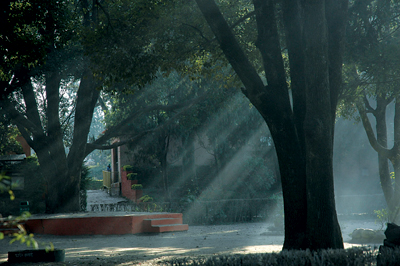
Kapoor trees line the pathway, catching the morning sunlight and bathing the area in a warm haze.
Looking back
The Jawalakhel Zoo, home to 116 species of mammals, reptiles, birds and fish, is the oldest and largest zoo of the country. Every day though, the scene resembles that at a rock show – a huge production that goes on for all 365 days of the year, seven days a week with the animals as its star attraction. The huge star cast never disappoints. Worthy of mention, is how the zoo came about in a time when the rulers were less inclined towards conservation of animals and more trigger-friendly.
The establishment of the zoo dates back several decades, to the time of the Rana oligarchy in Nepal. Our history books are rife with accounts of how Rana rulers were always looking to impress visiting dignitaries. One way they did this was by taking these guests into the wild of the Tarai for game hunting. Several books documenting the times carry pictures of these Rana rulers alongside these guests posing with their killings.
Interestingly, Rana era Prime Minister Juddha Shumsher Rana, known to be more progressive than what was the norm then as well as a reformist, established the zoo as a private body in 1932 A.D. Historians mention how the zoo’s present premises were actually the stable grounds of the extensive collection of animals belonging to the Rana rulers. The serene central pond where visitors love to circle the Saras Cranes’ floating island on pedal boats was actually a source of water for the residents of Patan. The pond however, was built during the rule of Malla dynasty king Siddhi Narsingh Malla.
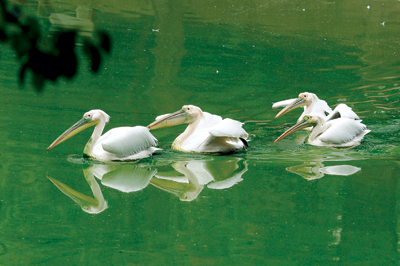 With the political changes of 1950, the ownership and management of the zoo came under the Government of Nepal (GoN). On the auspicious occasion of the golden jubilee birthday celebration of former king Birendra Shah in December 1995, the GoN formally entrusted the overall management of zoo to the National Trust for Nature Conservation (NTNC), an autonomous, non-profit making organization for 30 years.
With the political changes of 1950, the ownership and management of the zoo came under the Government of Nepal (GoN). On the auspicious occasion of the golden jubilee birthday celebration of former king Birendra Shah in December 1995, the GoN formally entrusted the overall management of zoo to the National Trust for Nature Conservation (NTNC), an autonomous, non-profit making organization for 30 years.
Running a tight shift
With so many different animals brought together from all over the country and even flown in from different corners of the world, 1,013 individual animals in total representing 116 different species of mammals, birds, reptiles and fish within 6 hectares of walled greenery, there is a lot of drama at the zoo to keep the 73-strong staff busy.
From issuing the tickets at the entrance, supervising huge numbers of both animals and visitors to preparing and feeding the animals’ carefully designed diets, it is a huge undertaking; one that the behind-the-scenes team handles with élan.
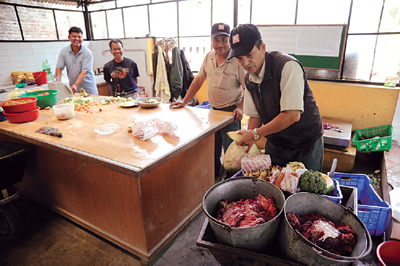
The kitchen staff prepares for the day’s meals.
The zoo also has its own in-house veterinary team, a very important part of the staff who continually monitor the health of the animals, their diets and make critical decisions regarding when to keep cage-mates together and when to separate them.
Another important part of the establishment that requires a huge amount of work is the zoo’s kitchen. The kitchen prepares at last a hundred kilos of buff, chicken and fish combined and four hundred kilos of different kinds of beans every day for the animals. A huge amount of fodder is also a part of the animals’ diet. In order to educate children about animals, the zoo’s education program organizes activities where students can help around the kitchen as well as feed the animals in a controlled environment.
An astounding figure of a million people visit the zoo annually, with the premises seeing close to 34,000 visitors during the annual Bhoto Jatra festival. The festival sees tens of thousands throng the area, to catch a glimpse of a historical bhoto (vest) strewn with precious stones, is celebrated right outside the premises of the zoo. Before and after the festival, huge crowds descend on the zoo, a rare day off for people working in the capital’s government offices. In this context, the zoo is also a site of historical and cultural significance for multi-ethnic communities, a place where people can mix, interact and socialize even, bound by a common enthusiasm and curiosity regarding animals.

A Garuda gets its meal ready by cleaning it with its beak.
Such a large crowd also means a lot of waste, in the form of candy wrappers, plastic bags and the like. Besides this, the zoo produces a lot of from its everyday operations. The zoo’s waste management system processes the organic portion of this waste. A private company handles the management of the inorganic waste.
A tour of the zoo with a guide gives one an idea of just how much hard work goes into getting the zoo “ready” for its visitors every day. The behind the scenes efforts of the team deserves much appreciation. Enrichment of the space entails small things that most visitors will miss but that are essential for the wellbeing of the animals. For instance, the greens in an enclosure might seem random, but it seldom is the case. They are actually specific plants that are conducive for the health of the animal. Much thought goes into the design of the enclosure. What a visitor will assume to be a dirty enclosure for birds with dry twigs and leaves is actually raw material for them to build their own nests. Similarly, food placement on branches and slightly hard to reach places ensure that the animals will make an effort and get some exercise in the process.
The zoo’s hospital uses the Animal Record Keeping System (ARKS) software - which is the standard software used by zoos around the world as well as the International Species Information System (ISIS) to keep track of all the animals. However, even with a system in place, not everything goes according to plan. When Kanchha, 20 and Kanchhi 22, 2 Indian Rhinoceroses, were housed together in hopes of procreation, it made international news with headlines reading, “Rhinoceroses in honeymoon suite”. As far as the zoo authorities are concerned, the rhinos have never mated - a fact attributed to its previously small enclosure. With a new and larger enclosure, offering more privacy, hopes are high for a baby rhino joining the family soon. Nepal’s rhino population fell dramatically during the 10-year Maoist rebellion that ended in 2006, as army guards stationed in wildlife reserves to deter poachers left to fight the rebels. There are roughly 450 rhinos in Nepal now. The new enclosure was financed by Ace Development Bank, a local bank whose mascot is the one-horned rhino.

Here comes the food!
A Multinational Star Cast
The star cast consists of more than 33 mammal species, 61 different kinds of birds, 8 reptiles and 17 fish species. Of the 38 endangered species found in Nepal, the zoo exhibits an amazing 15. This allows guests to a unique experience with no other destination in the country and probably in the world having these 15 animals together within a common compound.
A prized possession here, amongst the endangered species list is the Royal Bengal Tiger, a breed that is in rapid decline in the world and only 121 of which are of breeding age remain in the country’s wild. The zoo has four Royal Bengal Tigers at present. The Great Indian One-horned Rhinoceros too falls in the endangered category. Found in Nepal’s Tarai region, especially in the lush forests of Chitwan National Park and Bardia National Park, their numbers are thinning too with less than 250 of them remaining.
Besides endemic species, the zoo also houses some exotic species. The African Hippopotamus lounging about in a small pond in its enclosure is from Thailand and was exchanged with a pair of Daanphes, the national bird of Nepal. Similarly, the Siamangs are from Malaysia and in exchange for a pair of Saras Crane. The African Ostrich that prances about its area, a look of perpetual surprise on its face, was brought in exchange for a common leopard.

A welcome respite from citylife.
Some species on the other hand, have been rescued during crackdowns on animal traffickers before they and the animals or birds hop on an international flight. Numrous exotic pheasants, a sulphur-crested cockatoo and several lorikeets have been rescued from the airport and have since found a home at the Jawalakhel Zoo.
Zoo to the rescue
A very interesting and important part of the zoo’s operations is its rescue operation services. Owed to deforestation in previous habitats of the wild, there are several cases of wild animals venturing out into villages and even towns. Most times, animals such as deer are only out for a drink of water, other times they come out by accident. In such cases, nervous villagers often trap the animals, sometimes even harming the animal physically. The zoo’s rescue team is approached in some cases wherein the team helps pacify the animal, brings it to the zoo’s hospital for a medical inspection and upon being fit, they are freed in their natural habitat.
Narayani, a five-year old Royal Bengal Tiger, was rescued by the team after its mother, a man-eater was killed by locals in Divyanagar Village Development Committee. After spending time in a small cage in Kasara, the tiger was presented to the zoo in December, 2010. After being placed a strict quarantine, she was finally “mixed” with a mal tiger – Shiva, and placed in her present enclosure. Today, Narayani draws a maximum of visitors to the bridge over her enclosure, as she basks in the sun or strolls down neared for a drink, much to the delight of camera-happy visitors.
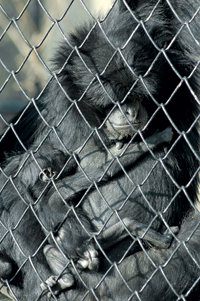
A family of Siaman monkeys originally from Indonesia.
Kanchhi, an Indian Rhinoceros was rescued too after a flood ravaged the area near the Rapti river where she is presumed to have been living. Chitwan National Park authorities immediately launched a successful rescue operation, after which the month old rhino was brought to the zoo.
Helping Hands
Under the zoo animal welfare scheme, the zoo has already started an Animal Sponsorship program since 1997. This program is mainly to support animal feeding. The sponsorship cost varies according to the species, number and enclosure size. The sponsorship program will allow the sponsors to earn an appreciation from the million visitors through advertising their name at designated place provided by the zoo.
Nepali business houses and banks have not shied away from doing their bit either. The VOITH group, in addition to its various social welfare activities under its “Little Things We Do” campaign, has also sponsored building the entrance to the zoo as well as the enclosures for the tiger and the chimpanzee.
Bank of Kathmandu and Ace Bank too have done their part. Ace Bank sponsored the rhino enclosure to facilitate breeding; the rhino is also the bank’s choice for company mascot. Bank of Kathmandu
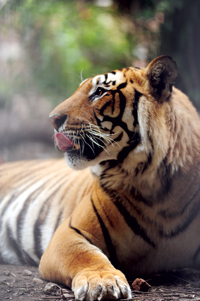
A Royal Bengal Tiger wakes up after a leisurely siesta.
A Place of Learning
The zoo has four fundamental objectives - conservation of animals, education about animals, research and recreation. Different zoos focus on different objectives based mostly on the requirements of the animals housed there. Many zoos focus on breeding while some focus on wildlife behavior.
The Jawalakhel Zoo has tried to give equal attention on all four objectives. However, its educational programs deserve special mention for outstanding performance in imparting crucial education on the zoo and its significance to anyone and everyone who is interested. The zoo has through its own initiative, conducted successful education programs since 1997. Keeping in mind that educating children is the best way to ensure a zoo and wildlife-friendly future, the zoo has special initiatives for young animal enthusiasts. 200,000 students have gained from these programs.
Children can take part in animal feeding sessions before which they get a tour of the kitchen where they can help prepare the animals’ meals. Afterwards, interested children can take a guided night tour of the zoo where expert guides speak on the behavior of various nocturnal animals such as porcupines and the clouded leopard. Center for Environmental Education (CEE), India verified the quality and effectiveness of these programs. Children can join partake in the education programs either through a request from the child’s school or through a membership of the Friends of the Zoo (FoZ) program.
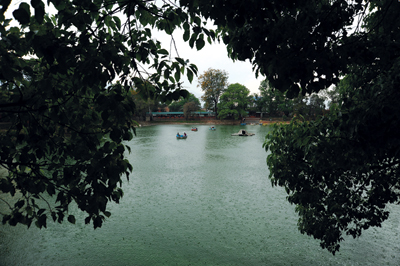
An unexpeted afternoon downpour brings out the green at the zoo; the tone lends the place more drama.
The zoo is also an excellent place for research work. For one, it provides a large and important variety of animals that represent different environmental systems. These systems refer to locations around the country and across the globe too. Second, since the animals and birds are housed in secure enclosures, they provide the researcher with an opportunity to inspect the animals and their behavior closely.
These opportunities are but a few of many activities that the zoo can play host to. An oasis of greenery smack in the middle of the up and coming district of Lalitpur, the Jawalakhel Zoo, even with a million guests each year, remains new and unexplored for a large part of its population.

The zoo’s premise also houses an old temple that has been a part of the property from the beginning.
One rainy afternoon at the zoo, I sought refuge under a large tree by the huge zoo pond. The foliage around me turned shades of green no city dweller could have witnessed. I smelt deliciously damp earth, heard the sounds of birds and animals I didn’t know the names of and felt a joy that was alien to me. If I were to ignore the few and far in between concrete structures, I could easily imagine myself in a different place, in a different time.
The great news then is that the zoo is here, now. The show is on, when will you go?
The serene central pond where visitors love to circle the Saras Cranes’ floating island on pedal boats was actually a source of water for the residents of Patan. The pond however, was built during the rule of Malla dynasty king Siddhi Narsingh Malla.
Opening Hours - 10am – 5pm
Location - Jawalakhel, Lalitpur
Additional summer attraction - Fishing at the zoo’s pond from April to October
Friends of the Zoo (FOZ)
The central zoo has been successfully running a special membership based program called the Friends of Zoo, with a network of schools in Kathmandu Valley. Aimed at imparting conservation education through activities based at the zoo, the program organizes annual scheduled conservation educational activities for FOZ members. Students who are members can participate in various activities and events such as competitive essay and drawing programs, training programs for solid waste management and bird identification, summer and winter camps, animals feeding for zoo animals and night guided tour in the zoo.
On top of this, FOZ members receive free issues of the zoo newsletter. The program is open to all national, international, individuals, families and students. Membership is open to all including foreign nationals.
The star cast consists of more than 33 mammal species, 61 different kinds of birds, 8 reptiles and 17 fish species. Of the 38 endangered species found in Nepal, the zoo exhibits an amazing 15. This allows guests to a unique experience with no other destination in the country and probably in the world having these 15 animals together within a common compound.










